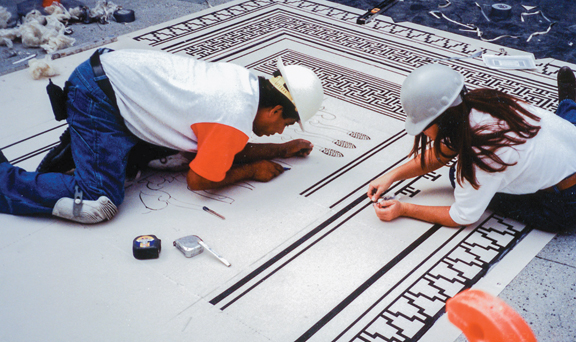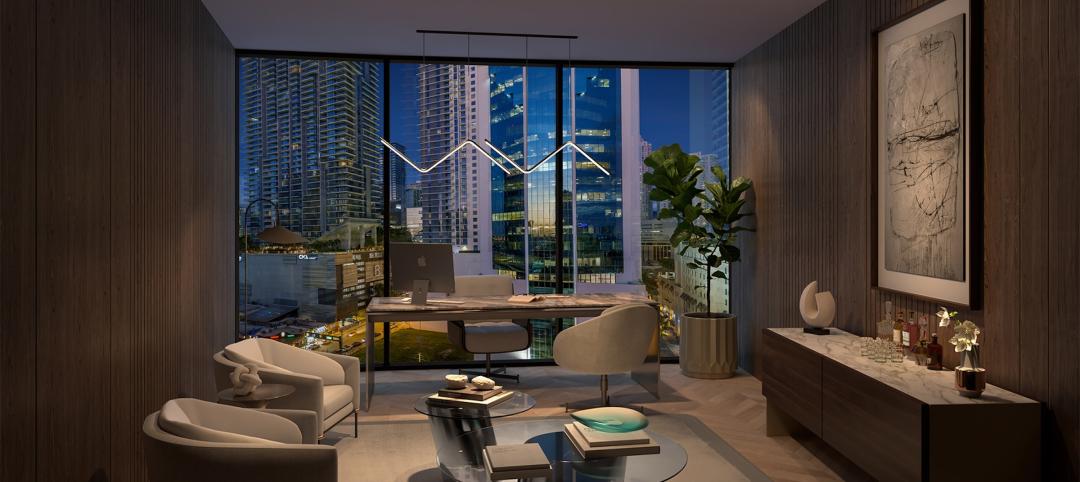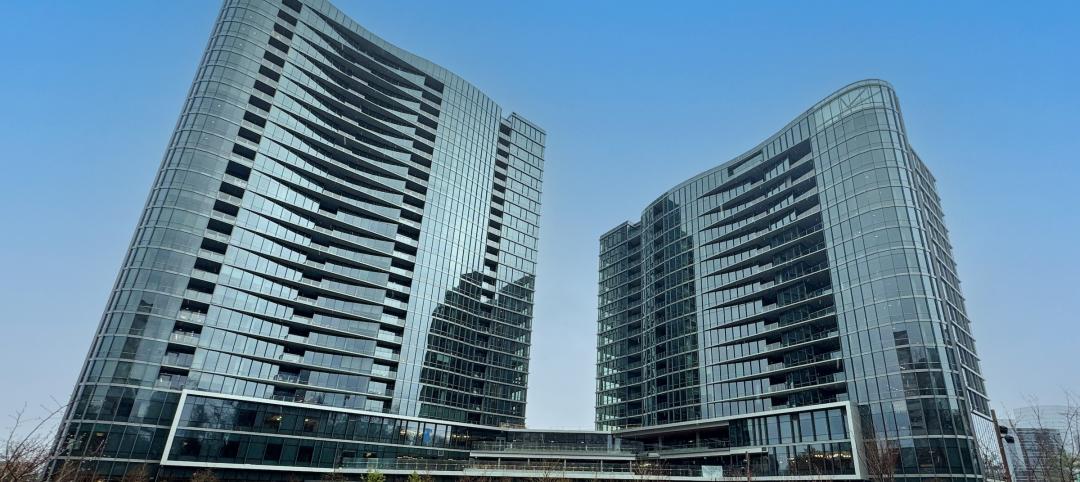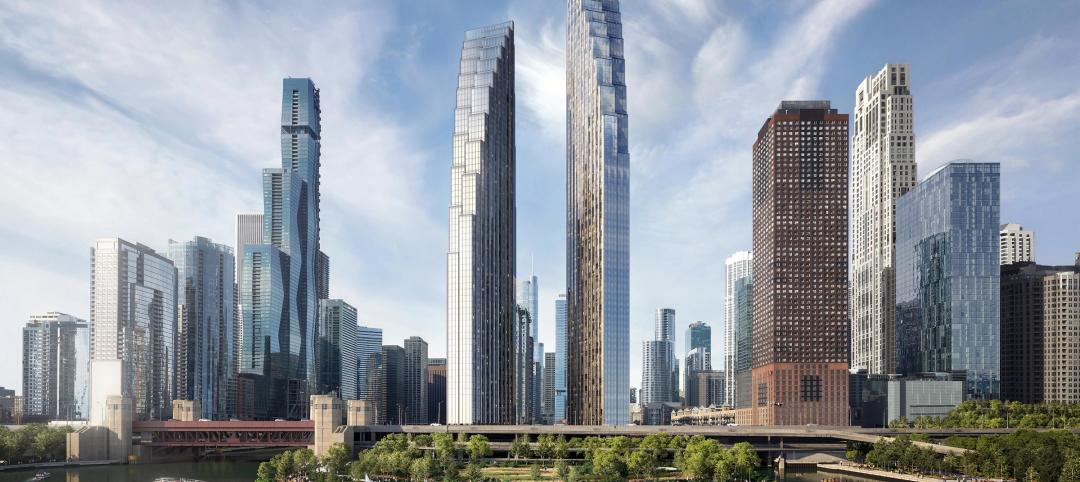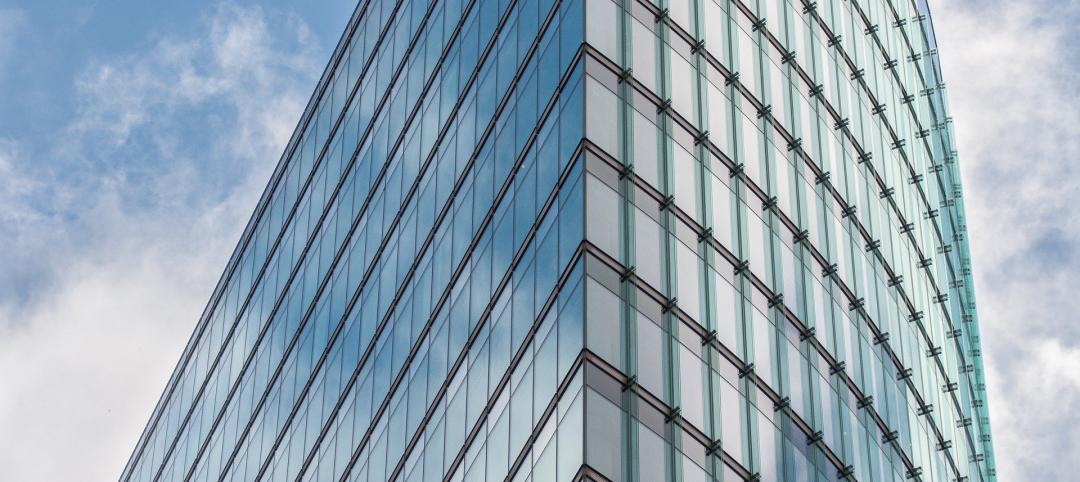Building Teams and their clients tend to think of a decorative concrete contractor as just another trade to be fit into the construction schedule, preferably at the lowest possible cost. But installing decorative concrete can be a delicate process, making planning for the construction crucially important.
At one time, decorative concrete came in only a few finishes—colored concrete, acid-etch stained, and stamped patterns. Today, there’s an almost infinite number of finishes available for horizontal and vertical surfaces—stamped, textured, integral and dust-on, colored, acid etch, dye (water and solvent), stampable overlays, self-level overlays, micro-toppings, stencil, engraved, form liners, diamond polished, sandblast, exposed aggregate, and coatings (epoxy, urethane, and acrylic). Finishes can also be combined with other finishes.
The possibilities are limited only by creativity of the designer and concrete contractor, yet it’s that very creativity that makes using decorative concrete so attractive. The problem is that concrete is very sensitive to a wide range of variables that can negatively impact the outcome.
ALSO SEE: 8 Innovations That Will Rock Your Next Concrete Project
To learn more about how to control these variables and thereby make decorative concrete a successful component of your next project, we consulted Mike Miller, Managing Principal of The concretist, Benicia, Calif. (www.theconcretist.com), one of the oldest decorative concrete contractors in the business. The term “concretist” refers to “one who practices concrete poetry,” and Miller himself is widely known for the almost poetic nature of his work.
1. Correctly assess—and manage—client expectations.
Miller says projects should start with the owner providing a full description, preferably in writing, of what the finished product should look like. Then the contractor can respond with what’s physically, aesthetically, and financially feasible. Sometimes owners have unreasonable expectations; early discussion can help manage those expectations.
What Building Teams should do when specifying decorative concrete:
1. Correctly assess—and manage—client expectations.
2. Choose the right decorative concrete contractor.
3. Carefully schedule the work of other trades to avoid undue damage to the concrete.
4. Provide the right protection for the finished work.
5. Negotiate an agreement with the client/owner on post-occupancy maintenance.
Decorative concrete usually isn’t structural in nature, although specifications are often written as if they were. For instance, a specification might require concrete with high compressive, tensile, or flexural strengths cured in a prescriptive manner. Or a specification might require “green concrete” with a certain percentage of the portland cement substituted with fly ash, slag cement, or other pozzolanic materials.
Miller’s advice: Focus first on the requirements for a good decorative installation; otherwise the work might meet all the structural requirements but be rejected for aesthetic reasons. For example, applying the usual curing specification for plain concrete to decorative work could have disastrous results, to the point of permanently damaging the look of decorative work. He urges Building Teams to use pre-job conferences to focus on the “dryness” of concrete or the slab relative humidity needed to start finish work rather than how to retain more moisture for curing purposes.
2. Choose the right decorative concrete contractor.
There can be significant variations in the creative abilities of decorative concrete contractors, says Miller. If you want highly creative work you must find a contractor who can perform at that level and who also possesses good craft skills. Contractors tend to specialize in certain types of decorative concrete these days, so you’ll have to narrow your search to get the right one for your job.
A word of caution: Miller says some decorative concrete contractors don’t place-and-finish concrete and wouldn’t know how to do it if asked, so you might have to hire a place-and-finish concrete contractor in addition to a decorative specialist.
3. Carefully schedule the work of other trades to avoid undue damage to the concrete.
Unfortunately, decorative concrete is highly susceptible to damage by other trades, more so than tile or other finished floor surfaces. Damage to concrete slabs can occur before decorative work begins or afterwards. Plumbers have been known to spill cutting oil, hot solder, and plastic pipe glue on slabs. Carpenters seem to think that any flat surface was put there so that they could pile stacks of lumber on it. Even trade workers’ footprints on floors that are hard but still considered “green” can become visible when acid-stain finishes are applied. Shoe soles also contain oils that may act as a resist.
To avoid conflicts with other trades, Miller recommends scheduling this work starting on a Friday afternoon and proceeding through a weekend. With no one on the job site to cause problems or delays, he says that’s the best chance for success.
4. Provide the right protection for the finished work.
The common belief about concrete is that it gets hard, becomes even stronger over time, and that’s pretty much it—no need to worry further. But that is not the case. Concrete remains vulnerable because its chemistry continues to change as it ages, and water on slab surfaces can bring about other physical and chemical changes. That’s why it’s so important to include a plan for protecting the finished work in pre-job meeting discussions.
Miller says covering material must allow moisture vapor from concrete to pass through while not allowing products that can stain to reach the surface of the concrete. The responsibility for the finished work is not a trivial matter. Since the concrete contractor cannot be expected to stay on the job until the concrete has fully cured, the responsibility for protecting the decorative work falls to the general contractor. However, that does not absolve the decorative contractor of all responsibility. The subcontractor should suggest the best protective products to use and perhaps even install them the first time.
5. Negotiate an agreement with the client/owner on post-occupancy maintenance.
A long-term maintenance plan should be part of the discussion your Building Team has with the client and facilities staff before construction begins. There are several ways to seal decorative work; each sealer provides a unique appearance. If an owner wants a glossy “wet look,” an epoxy, polyaspartic urethane, or acrylic finish is a good choice. These finishes must be renewed per the manufacturer’s recommendation. The accepted standard is that pedestrians should walk on the sealer, not on the concrete.
ALSO SEE: The world’s first building made from carbon-fiber reinforced concrete starts construction in Germany
If the owner wants a natural concrete look without a glossy appearance, there are penetrating sealers on the market that restrict pore openings so that dirt and other staining materials will not penetrate the surface.
Diamond-polished floors present additional maintenance problems. Owners typically want these floors to have a high-gloss shine, but dirt and fine grit become abrasive under foot traffic, dulling the surface gloss over time. Some big-box retail companies have maintenance programs to remove dirt and grit on a frequent schedule. In grocery stores food spillage must also be removed and cleaned as it occurs.
The inspirational aspect of decorative concrete
There are good reasons for the growing popularity of decorative concrete. It’s in our nature as humans to surround ourselves with creative expression and color; we like to be emotionally pleased by our environment.
Today, there are many more options for Building Teams to provide that kind of satisfaction through the use of decorative concrete. That’s why it’s important for Building Teams to work with their decorative concrete contractors to meet these heightened client expectations and ensure a long and useful life for these beautiful, inspiring surfaces. +
--
Joe Navsik, a freelance writer in the Chicago area, is a former editor at Concrete Construction magazine.
Related Stories
MFPRO+ New Projects | Jul 2, 2024
Miami residential condo tower provides a deeded office unit for every buyer
A new Miami residential condo office tower sweetens the deal for buyers by providing an individual, deeded and furnished office with each condo unit purchased. One Twenty Brickell Residences, a 34-story, 240-unit tower, also offers more than 60,000 sf of exclusive residential amenities.
Student Housing | Jul 1, 2024
Two-tower luxury senior living community features wellness and biophilic elements
A new, two-building, 27-story senior living community in Tysons, Va., emphasizes wellness and biophilic design elements. The Mather, a luxury community for adults aged 62 and older, is situated on a small site surrounded by high-rises.
Smart Buildings | Jul 1, 2024
GSA to invest $80 million on smart building technologies at federal properties
The U.S. General Services Administration (GSA) will invest $80 million from the Inflation Reduction Act (IRA) into smart building technologies within 560 federal buildings. GSA intends to enhance operations through granular controls, expand available reporting with more advanced metering sources, and optimize the operator experience.
Sustainability | Jul 1, 2024
Amazon, JPMorgan Chase among companies collaborating with ILFI to advance carbon verification
Four companies (Amazon, JPMorgan Chase, JLL, and Prologis) are working with the International Living Future Institute to support development of new versions of Zero Carbon Certification.
K-12 Schools | Jul 1, 2024
New guidelines for securing schools and community spaces released by the Door Security and Safety Foundation
The Door Security and Safety Foundation (DSSF), in collaboration with Door and Hardware Institute (DHI), recently released of “Are Your Door Openings Secure?.” The document provides guidelines to equip school administrators, building management personnel, and community leaders with a clear roadmap to create a secure and safe environment.
University Buildings | Jun 28, 2024
The American University in Cairo launches a 270,000-sf expansion of its campus in New Cairo, Egypt
In New Cairo, Egypt, The American University in Cairo (AUC) has broken ground on a roughly 270,000-sf expansion of its campus. The project encompasses two new buildings intended to enhance the physical campus and support AUC’s mission to provide top-tier education and research.
MFPRO+ New Projects | Jun 27, 2024
Chicago’s long-vacant Spire site will be home to a two-tower residential development
In downtown Chicago, the site of the planned Chicago Spire, at the confluence of Lake Michigan and the Chicago River, has sat vacant since construction ceased in the wake of the Great Recession. In the next few years, the site will be home to a new two-tower residential development, 400 Lake Shore.
Codes and Standards | Jun 27, 2024
Berkeley, Calif., voters will decide whether to tax large buildings with gas hookups
After a court struck down a first-in-the-nation ban on gas hookups in new buildings last year, voters in Berkeley, Calif., will have their say in November on a measure to tax large buildings that use natural gas.
Mass Timber | Jun 26, 2024
Oregon State University builds a first-of-its-kind mass timber research lab
In Corvallis, Oreg., the Jen-Hsun Huang and Lori Mills Huang Collaborative Innovation Complex at Oregon State University aims to achieve a distinction among the world’s experimental research labs: It will be the first all-mass-timber lab meeting rigorous vibration criteria (2000 micro-inches per second, or MIPS).
Sustainability | Jun 24, 2024
CBRE to use Climate X platform to help clients calculate climate-related risks
CBRE will use risk analysis platform Climate X to provide climate risk data to commercial renters and property owners. The agreement will help clients calculate climate-related risks and return on investments for retrofits or acquisitions that can boost resiliency.


